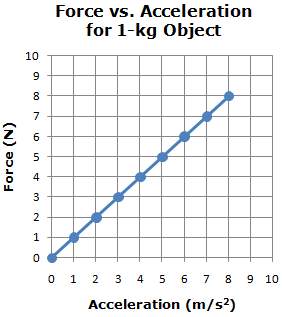
Physics, 22.08.2019 11:30 alex12everett
John wanted to investigate newton's second law to see how changing the force applied to an object affects the object's motion. he used eight different values of force applied to the same object, which had a mass of 1 kg. this resulted in eight different values for acceleration. john's results are shown in the graph below, which plots force vs. acceleration for the 1-kg object. examine the graph, and then answer the question that follows. based on the graph above, it can be concluded that
a. the acceleration of an object decreases as the force applied to the object increases.
b. the acceleration of an object remains the same as the force applied to the object increases.
c. the acceleration of an object increases and decreases randomly as the force applied to the object increases.
d. the acceleration of an object increases as the force applied to the object increases.


Answers: 1


Another question on Physics

Physics, 21.06.2019 22:30
A1200 kg car traveling north at 10 m/s is rear-ended by a 2000 kg truck traveling at 30 m/s. what is the total momentum before and after the collision?
Answers: 3

Physics, 22.06.2019 08:00
While studying chemical reactions and conservation of matter, sarah's class conducted a variety of experiments. sarah and her lab partner found the mass of a wax candle and placed the candle in a flask. the students lit the candle and let it burn to completion. all that was left was wax and charred candle wick. per their teacher's instructions, the students found the mass of the products. their data can be seen in the data table. formulate a hypothesis the students could test to explain why the experiment did not support the law of conservation of matter. a) the students could repeat the experiment using different candles; there might have been a flaw in the candle. b) the experiment should be repeatable. the students should run several trials and then take an average of the after mass in each trial. c) the students should have someone in the class check their measurement skills as they repeat the experiment. they may have made an error using the balance. d) the students should burn the candle in a container that has some type of lid so that any gas that is a product of the reaction can be contained and massed. submit
Answers: 2

Physics, 22.06.2019 18:00
Astone is thrown with a speed v0 and returns to earth, as the drawing shows. ignore friction and air resistance, and consider the initial and final locations of the stone. which one of the following correctly describes the change δpe in the gravitational potential energy and the change δke in the kinetic energy of the stone as it moves from its initial to its final location? options a.δpe = 0 j and δke = 0 j b.δpe is positive and δke is negative c.δpe = 0 j and δke is positive d.δpe is negative and δke is positive e.δpe = 0 j and δke is negative
Answers: 3

You know the right answer?
John wanted to investigate newton's second law to see how changing the force applied to an object af...
Questions







Mathematics, 19.02.2021 23:10


English, 19.02.2021 23:10

History, 19.02.2021 23:10

History, 19.02.2021 23:10

Mathematics, 19.02.2021 23:10

Chemistry, 19.02.2021 23:10

Health, 19.02.2021 23:10

SAT, 19.02.2021 23:10


Arts, 19.02.2021 23:10

Mathematics, 19.02.2021 23:10

Chemistry, 19.02.2021 23:10

Mathematics, 19.02.2021 23:10



